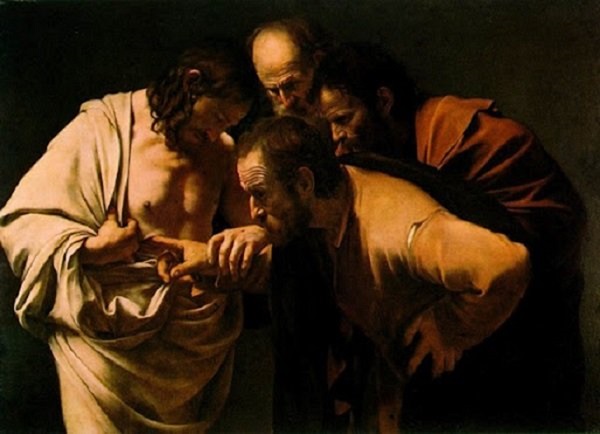Disbelief and Divine Compassion
3 May 2022a) Divine compassion, as a consequence of the mystery of divine self-emptying, isn’t restricted to the Cross and burial. It continues after the Resurrection as well. The risen Lord had no wish to impose the glad tidings on people by force. Nor did he require them to embrace the news unconditionally. As the glorified Lord, he agreed to be the object of investigation. He recognizes Thomas’ rational inability to believe and once more shows understanding of human doubt.
b) Let’s have a brief look at the Gospel [for Thomas Sunday] as recorded by Saint John the Evangelist (Jn. 20, 19-29). After the crucifixion and burial of Jesus, his disciples were scattered and their souls were filled with fear. They themselves were at risk of being identified by the Scribes and Pharisees. At the same time, they heard with disbelief the assurances of the myrrh-bearing women that they’d seen the risen Lord.

c) When the disciples gathered in the upper room on the evening of Sunday, ‘for fear of the Jews’, although the doors were locked, the Lord appeared to them and said: ‘Peace be with you’. At the same time he showed them his hands and side. He then breathed on their faces and said: ‘Receive the Holy Spirit.If you forgive anyone’s sins, their sins are forgiven; if you do not forgive them, they are not forgiven’. Thomas wasn’t with them when Jesus came. The other disciples told him: ‘We’ve seen the Lord’. He replied: ‘Unless I see the nail marks in his hands and put my finger where the nails were, and put my hand into his side, I will not believe’.
d) Eight days later, the disciples were again gathered together at the house, and Thomas was with them. Although the doors were closed, Christ came, and he stood in the midst of them and said: ‘Peace be with you’. He then said to Thomas: ‘Put your finger here; see my hands. Reach out your hand and put it into my side. Stop doubting and believe’. Thomas responded: ‘My Lord and my God’.
e) The first part of the Gospel reading, which refers to the appearance to the disciples without Thomas, is read in a variety of languages at the Agapi Vespers on Easter day. When people live the mystery of the Orthodox faith and their heart tastes the experience of the Cross and Resurrection, they feel the need to tell other people about it. So the light of the Bright Day is poured out onto other peoples and races, in other languages. In this way, albeit in a symbolic manner, we observe the commandment of Christ to preach the Resurrection ‘to all the nations’. Certainty regarding the truth compels us to witness concerning it to every person of good will. In our liturgical books, the Gospel is also quoted in Turkish and was deliberately read in Asia Minor, where obviously Turks came to hear it, as did crypto-Christians.
f) Over the centuries, the apostle Thomas has been the symbol of the ‘disbeliever’. And yet he wasn’t. He was genuinely searching for the truth. His doubt was genuine. He had no ideological axe to grind, nor was he possessed of an anti-Christian spirit. This is why Christ responded and dispelled his doubts. He appeared, and didn’t mind being touched by his ‘unbelieving’ disciple. The liturgical texts make mention of Thomas ‘ good disbelief’, because it engendered certain faith. At the end of the reading, it seems that the Lord chastised Thomas. ‘Because you have seen me, you have believed; blessed are those who have not seen and yet have believed’. In this way, Christians over the centuries are blessed for accepting and experiencing the message of the Resurrection.
g) It might be asked: ‘Why did the risen Lord choose to appear to the disciples, Thomas, and the myrrh-bearers rather than directly to those who crucified him, so that they’d also believe?’. Saint John Chrysostom provides the answer: ‘Had there been any hope of bringing them to faith, he wouldn’t have neglected to appear to everyone. This was shown with the raising of Lazarus, who’d been dead for four days and was raised by Christ before the eyes of all. Despite this, not only were they not attracted to belief, but became furious with Christ, to the extent that they wanted to kill both him and Lazarus’. In the end, the fact that the ‘disbelieving’ disciple sacrificed his life as a martyr in the far reaches of the East while spreading the message of hope that is the Resurrection, is further evidence of the Resurrection and proves the justice of divine compassion.






